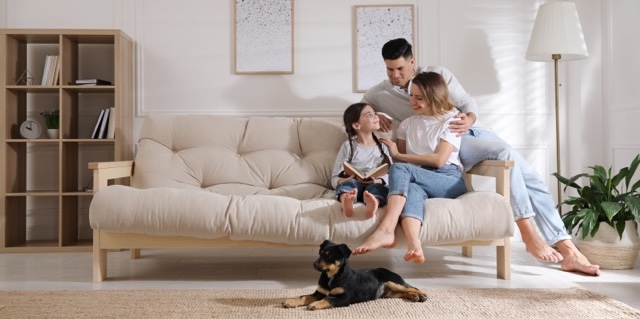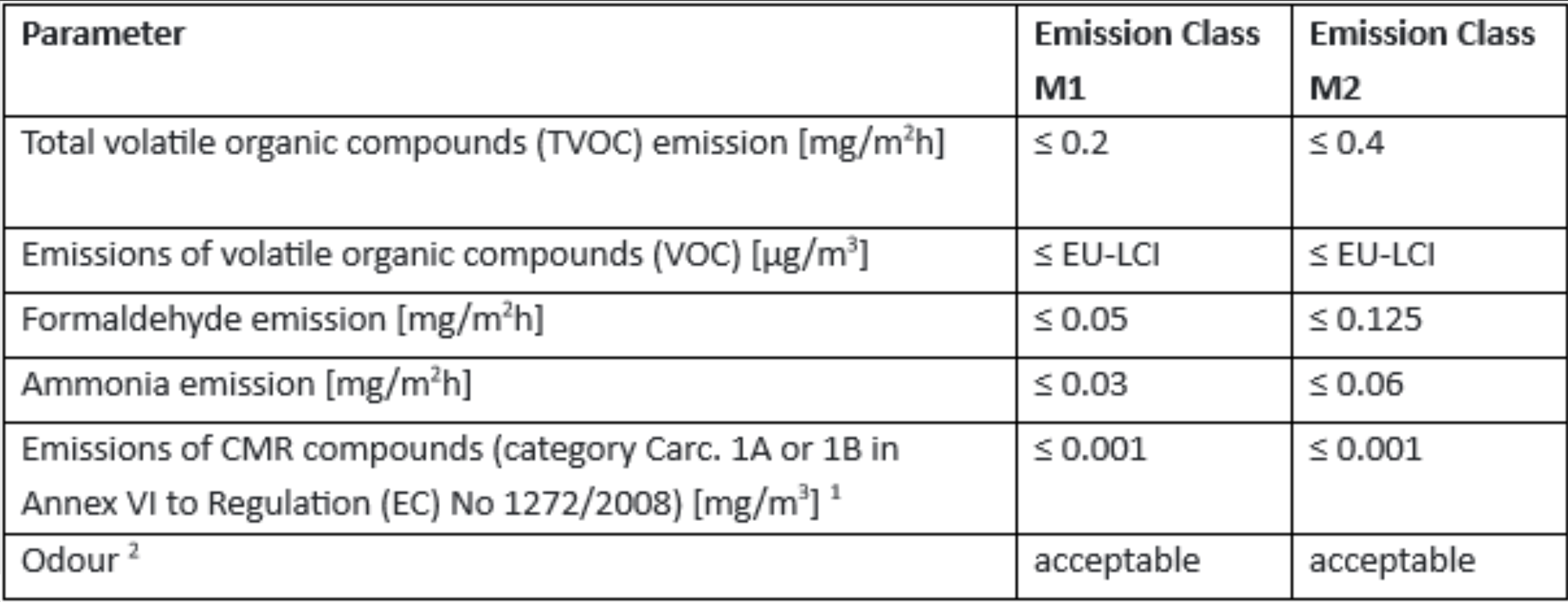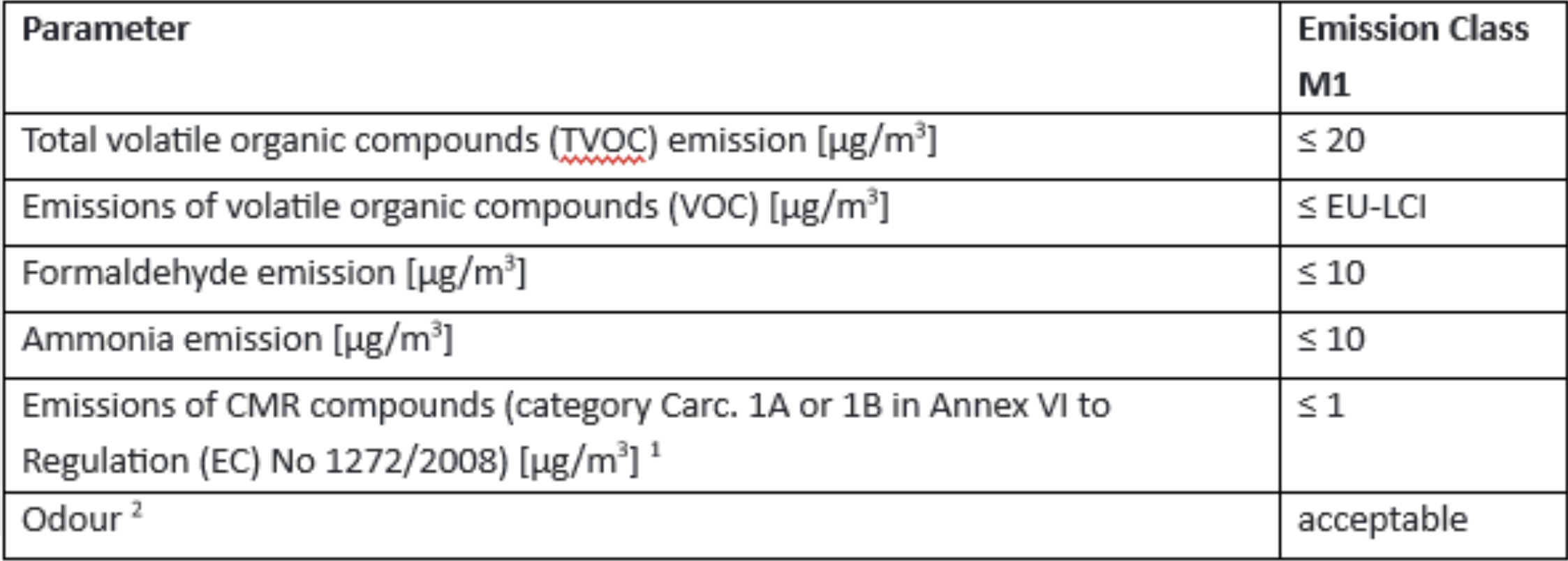
M1-classified product has been confirmed to be low emitting, which mean that the product releases only very low levels of chemical compounds into indoor air. The majority of building materials fall within the scope of the classification. An M1-classified product supports also the objectives of the EU taxonomy.

The Finnish M1 Emission Classification of Building Materials has successfully helped to improve indoor air quality for almost 30 years. The M1 Emission Classification, introduced in 1996, was created to promote the development and use of low-emitting building materials, fixed furniture, and office furniture. Good indoor environment requires that indoor air issues are considered at all stages of design, construction, and operation. The use of low-emitting building materials and fixtures is a significant part of this process , and helps to achieve good indoor air quality.

Low-Emitting Products for Better Indoor Air Quality
M1-classified product is proven to be low-emitting
The M1 Classification focuses on emissions from building materials and furniture into the indoor air, setting limit values for emissions of volatile organic compounds (VOC), formaldehyde, and ammonia as well as the acceptability of odour.
The M1 criteria are set for the longer-term emissions that are more relevant to indoor air quality, describing better the long-term exposure of the building user to the chemical emissions of materials. The M1 Classification does not set criteria for the primary emissions which typically decrease rapidly and therefore are not relevant for building users. For this reason, in the emission tests required by the M1 Classification, measurements are carried out after an aging period of 28 days (excluding office chairs, the emissions of which are examined after 3 days).
The M1 Classification label on the product indicates that the product is low-emitting, and its use supports good indoor air quality. The M1 Classification label is a type I ecolabel limited to the product's indoor air emissions in accordance with EN ISO 14024:2018.

The classification system is based on multidisciplinary expertise and impartiality
The Emission Classification of Building Materials is owned by Rakennustietosäätiö RTS sr and operated by Rakennustietosäätiö RTS’s subsidiary Rakennustieto Oy. The classification is overseen and developed by the principal committee Indoor Environment (PT 41) appointed by Rakennustietosäätiö RTS sr, in which representatives include construction products industry, developers, designers, and research institutes. Classification applications and matters related to classification decisions are handled confidentially by a separate impartial classification committee.
The voluntary M1 Classification for building materials is part of the broader Classification of Indoor Environment (Sisäilmastoluokitus) developed by the Finnish Society of Indoor Air Quality and Climate (Sisäilmayhdistys ry) and Building Information Foundation, RTS (Rakennustietosäätiö, RTS). The Classification of Indoor Environment is used by architects, designers, contractors, and manufacturers when building healthier and more comfortable buildings.
The classification decisions are based on the document Classification of Indoor Environment 2018 (Sisäilmastoluokitus 2018), the general rules of the classification and the classification criteria.
M1 is both a national and an international emission classification
In Finland, there is no legal obligation to test indoor air emissions from building materials or furniture, but the high emissions of building materials are known to reduce indoor air quality. Finland's solution to this challenge is based on a voluntary M1 classification system, which has been developed considering the Finnish concept of good indoor air.
The M1 Classification is more comprehensive than other European emission classifications, which typically focus only on VOC and formaldehyde emissions. M1 Classification differs from the international classifications by acknowledging also the emissions of ammonia and the odour of the product. This has also been noticed in the Nordic and Baltic countries, where the M1 Classification is widely used to demonstrate the low emissions of a product. However, when comparing the criteria of different emission classifications, it should be noted that different measurement and calculation methods may be used in different classifications, in which case the numerical values are not comparable.

M1 limit value examination helps to demonstrate that your products comply with the EU taxonomy.
According to the EU taxonomy, building materials must fulfill certain requirements to be classified as environmentally sustainable. These requirements include restrictions on emissions of carcinogenic, mutagenic, and reprotoxic (CMR) compounds, as well as formaldehyde emissions.
This means that manufacturers and suppliers of building materials must ensure that their products meet these requirements before being placed on the market. The EU taxonomy limit values apply to both the construction of new buildings and the renovation or renewal of existing buildings. The M1 limit value examination is an additional service of the M1 Classification, which is recommended for all products that are intended to be used inside the vapor barrier.
M1-classified product supports the objectives of EU taxonomy
It is possible to combine the M1 Classification with an limit value examination for building material emission, for the purpose of verifying compliance with the indoor air emission criteria of EU taxonomy or SINTEF approval.
Depending on the intended use, the limit value examination can have two different scopes:
1. emission of formaldehyde < 60 μg/m³ and emissions of carcinogenic compounds < 1 μg/m³ (scope required for taxonomy reporting)
2. emission of formaldehyde < 60 μg/m³, emissions of carcinogenic compounds < 1 μg/m³, and total volatile organic compound (TVOC) < 300 μg/m³ (scope suitable for taxonomy and SINTEF)
In principle, all emission test reports for products with valid M1 Classification are usable for the limit value examination. The limit value examination can be ordered both as part of the normal classification process as well as during an ongoing classification period.
The limit value examination is included in the M1 certificate, in which case the certificate:
The M1 Classification is a voluntary emission classification that importers and manufacturers can apply for their products. The Emission Classification of Building Materials is mainly intended for building materials and furniture used in ordinary residential and work premises. The scope of the classification includes:

The Emission Classification of Building Materials does not cover, for example: electrical appliances, interior textiles, plumbing products or sports equipment (e.g. basketball baskets). Ventilation products are covered by the Cleanliness Classification of Ventilation Products.
The Classification of Indoor Environment 2018 defines a set of inherently low-emitting materials that can be equated with M1-classified products when designing premises. These include uncoated brick, natural stone, glass and metal, ceramic tile, as well as boards and logs made of untreated aspen, birch, spruce, or pine. The VOC emissions of newly produced untreated board and log products may exceed the limit values for M1, but the emissions will reach lower level in the longer term. Inherently low-emitting products may not be marketed as M1-classified unless they have a valid M1 Classification granted by Rakennustieto.
The Emission Classification of Building Materials can only be granted by Rakennustieto. In addition to laboratory tests, an application for classification is always required. Further instructions on how to apply for M1 Classification can be found in the section Classification process.
All applications are submitted through the application portal. The application portal can be accessed only with personal credentials, which are created the first time you log in. By submitting an application, the applicant agrees to pay Rakennustieto Oy the valid classification fee and any other fees related to the granting of the classification.
When the application will be handled?
Applications must be submitted through the application portal well in advance before the classification meeting. Please note that applications submitted by email or post cannot be processed. Please do not combine several different products or product groups in one application. If the application requires supplementation or additional information, it will be requested from the contact person of the application before the classification meeting. If the application does not contain all the information necessary for processing, it will not be presented in the classification meeting until all the necessary information has been submitted.
All documents and information submitted will be treated confidentially. Classification meetings are held once a month (excluding July) and the dates of upcoming meetings can be found in the application portal. Normally, the decisions of the classification committee and the classification documents of approved applications are delivered to the e-mail address indicated in the application within two (2) weeks of the meeting.
Upcoming meeting dates can be found on the front page of the application portal.
If you have submitted an application in the application portal, you can follow its progress in the Applications section of the portal. Rakennustieto's customer service is open on weekdays 8.30 am to 4.00 pm, tel. +358 45 4900 747.
The M1 Emission Classification for building materials can only be granted by Rakennustieto. In addition to the laboratory tests, a classification application is always required for applying the classification. The application must include both the test report and the requested product information. Classification applications are submitted through the portal for processing and are handled confidentially by an impartial classification working group.
When starting to make an application in the application portal, please select the type of application from the available options. If the products to be classified are very similar in terms of use, as well as physical and chemical properties, they can be classified as a product group. Product grouping should be done before the testing and classification application phase so that the classification working group can select the product(s) to be tested, thus minimizing testing costs. In other cases, when classifying individual products, the thickest version of the product is tested. Order emission testing according to the M1 testing protocol from an authorized laboratory.
Figure 1. presents an overview of the classification process. More detailed instructions for different types of applications can be found in the application-specific guidelines presented on this page

New application
New classification application >
M1 Classification of a private label product >
The classification is expiring or has expired
Classification continuation application >
Classification renewal application >
Product grouping application >
Modifications and Additions
Change in an existing product group >
Change in company information or transfer of classification to another company >
Change in the composition or the manufacturing process of the product >
Product Removal
Removing a product from the M1 Classification >
New classification application
If a product is not yet M1-classified, the manufacturer or importer may apply for an M1 Emission Classification after successful emission testing in an approved testing laboratory. When applying for the classification, the test report shall not be older than one (1) year. The following information is attached to the new classification application:
M1 Classification of a private label product
All M1 Classifications of private label products shall be applied by the company selling or distributing the product under their brand. This ensures that the right to use the classification label is granted to the company marketing the product as theirs, and that customers looking for M1-classified products in the M1 database will find the product under the name of the company marketing and distributing the product under their brand.
No new tests are required if the private label product is identical to the product already approved to the M1, and the holder of the original certificate authorizes the use of their classification and test results as the basis of the classification of the private label product. The M1 certificate of the private label product is valid for the same time as the original certificate, and this might be less than the normal three (3) years, depending on the time point the original product was classified.
Continuation and renewal applications of the M1 Classification for the private label product should be coordinated between the manufacturer and the private label customer so that the applications are in sync. The classification fee for a private label classification is the same as for any product.
If the application for M1 Classification of a private label product is based on the M1 Classification of the manufacturer’s original product, the following documentation shall be attached to the private label product’s classification application (either a new application, an extension application, or a renewal application):
Classification continuation application
If there have been no changes in the manufacturing method, composition, or other characteristics of the product during the first 3-year classification period, the validity of the classification can be extended by a continuation application for one 3-year period without retesting. Continuation application can be submitted well in advance, approximately six (6) months before the classification expires. The validity of the continuation period of the classification continues from where the previous classification period ends, i.e. the applicant does not lose out by applying for a continuation before the end of the classification period, nor wins anything by applying for an extension late. The following information is attached to the classification continuation application:
Classification renewal application
Once the product has been M1-classified for a total of six (3+3) years, the product must be tested again and the classification renewed. When applying for the classification, the test report shall not be older than one (1) year. Renewal application can be submitted well in advance, approximately six (6) months before the classification expires. The validity of the renewal period of the classification continues from where the previous classification period ends, i.e. the applicant does not lose out by applying for a renewal before the end of the classification period, nor wins anything by applying for an extension late. The following information is attached to the classification renewal application:
Product groups should be brought to the classification committee for evaluation before retesting, so that the classification committee can select product(s) for testing. When renewing a classification, the tested products in product groups are always redefined by the classification committee, even if there have been no changes in the product group.
Product grouping
If the products to be classified are very similar in terms of use, physical and chemical properties, they may be classified as a product group. Please note that different thicknesses or colours/designs of a product with identical (i.e. 100% same) construction (e.g. a gypsum board manufactured in thicknesses 13 mm and 18 mm) is not a product group. For products such as these the thickest version must be tested. Nearly all product types can form product groups, but typical product types to form product groups are for instance screed-type products (e.g. levelling compounds, screeds, fillers, putties and mortars), flooring products, insulation, construction boards, fixtures and furniture, and paint-type products (e.g. paints, varnishes and coatings).
Product groups are formed free of charge by the classification committee based on the applicant's proposal. The similarity required for product grouping depends on the type of product, but, for example, the product grouping of fixed furniture is based on core material (e.g. chipboard and MDF products are in their own groups) and surface treatment (e.g. melamine and painted products are in their own groups). When assessing a product group, the classification committee also decides which product(s) should be tested so that the whole group can be M1-classified based on that testing.
So that the classification committee can assess with sufficient accuracy the chemical similarity and emission potential of the products in the proposed product group, detailed compositional information is needed for the product grouping. Safety data sheets and technical data sheet alone do not provide sufficient information for product grouping, but more detailed prescription information is needed for this. Like all information provided during the classification process, information related to product grouping is treated confidentially. Product type-specific product grouping templates can be requested from the Product Manager of the M1 Classification.
Product grouping application
Product grouping applications (one application per product group) are submitted through the application portal and shall include the following documentation:
Once the product grouping application has been processed and the applicant has been provided with information on which product(s) should be tested (generally within two weeks of the meeting in which the application has been evaluated), the applicant may contact any of the approved laboratories to arrange testing. The laboratory will provide more detailed instructions for sampling, sample delivery etc. Testing fees are paid directly to the testing laboratory by the applicant, Rakennustieto is not involved in the testing or its costs. After successful testing, M1 Classification application for the product group is submitted through the application portal. The classification fee of a product group is based on the number of products in the group.
M1 limit value examination
It is possible to combine the M1 Classification with anemission limit value examination, for the purpose of verifying compliance with the indoor air emission criteria of EU taxonomy or SINTEF approval. The limit value examination can be ordered both as part of the normal classification process (i.e. when making changes to an existing classification decision or when applying for a new classification or continuation/renewal of an old classification) and during an ongoing classification period. The limit value examination is included in the M1 certificate is only available in Finnish and English.
Depending on the intended use, the limit value examination can have two different scopes:
All new tests carried out in accordance with the M1 test protocol, as well as all tests of products with valid M1 Classification, serve as such as a basis for the examination of limit values. Thus, the limit value examination does not require new tests, but it is a prerequisite that the existing test report contains all the necessary information and is available.
The limit value examination is ordered through the application form. If the limit value examination is ordered during an ongoing classification period without any changes to the content of the classification, the following information shall be included in the application:
Parallel product name
It is possible to add parallel product name(s) both when applying for a classification and during an ongoing classification period. Parallel product names are identical (i.e. 100% the same) in composition and manufacturing process. If the products are only similar (i.e. the composition is very similar, but some modifications have been done) in composition and manufacturing process, they are not parallel product names, but can form a product group. When adding a parallel product name, the following documentation is attached to the application:
Change in an existing product group
Changes (additions or deletions) to a product group can be proposed both when applying for the classification and during an ongoing classification period. When proposing an addition to a product group, the following documentation is attached to the application:
If product names are also deleted in connection with the addition, information on the products to be removed shall be added to the above-mentioned application for addition. If products need to be removed from a product group during an ongoing classification period without any further changes to the group, see the section Removing a product from the classification .
Change in product name
The name of a classified product can be changed both when applying for a classification and during an ongoing classification period. For those looking for M1-classified products to find the products in the M1 database, it is advisable update the product name as soon as possible after the change has entered into force or even before the change takes place (if necessary, both the new and the old names can be M1-classified at the same time, see the section Parallel product name. When changing the name of the product, the following documentation is attached to the application:
The M1 Classification process does not include factory audits, but the company applying for the classification must have an acceptable quality assurance system in place. Composition analyses tell nothing about the indoor air emissions of the product, so the M1 Classification does not test the composition of the products. M1-classified product is presumed to comply with the legal and binding requirements for that product type (e.g. CE marking and REACH), but these are not considered as part of the classification process. M1 does not consider emissions during the installation of products or take a position on issues related to occupational safety, but chemical building materials (e.g. paints, varnishes and screeds) shall have a safety data sheet.
Change in company information or transfer of classification to another company
Changes can be made to the information of the classification holder both when applying for a classification and during an ongoing classification period. For those looking for M1-classified products to find the products in the M1 database, the details of the classification holder should be updated as soon as possible after the change has entered into force. When changing the details of the classification holder, the following documentation is attached to the application:
Change in the composition or the manufacturing process of the product
If changes are made to the composition or to the manufacturing process of the product that may have an impact on the emissions of the product, Rakennustieto must be notified of these changes in advance. Based on the information provided, the classification committee assesses whether the product or product group needs to be retested or not. When submitting a notification of changes, the following documentation is attached to the application:
Removing a product from the M1 Classification
The holder of the classification may relinquish the Emission Classification of a product during ongoing classification period, if for instance the product is discontinued. As a result, the product is removed from the M1 database and the right to use the classification label is cancelled. The removal notification shall include a list of product names to be removed.
The M1 Classification process does not include factory audits, but the company applying for the classification must have an acceptable quality assurance system in place. Composition analyses tell nothing about the indoor air emissions of the product, so the M1 Classification does not test the composition of the products.
M1-classified product is presumed to comply with the legal and binding requirements for that product type (e.g. CE marking and REACH), but these are not considered as part of the classification process. M1 does not consider emissions during the installation of products or take a position on issues related to occupational safety, but chemical building materials (e.g. paints, varnishes and screeds) shall have a safety data sheet.
Before applying for an Emission Classification of Building Materials, the product shall be tested in a laboratory approved by Rakennustieto according to the M1 testing protocol. All practical matters related to the testing, such as sampling, the required number of samples and the method of packaging and delivery of the product sample, are instructed by the laboratory.
The applicant is responsible for the costs related to the testing and pays them directly to the testing facility. The applicant shall document the sampling of the product sample using a sampling report from the laboratory and this sampling report shall accompany the product sample to the laboratory.
The emission testing required by the M1 Classification is based on the European harmonised test standard EN 16516 (Construction products: Assessment of release of dangerous substances. Determination of emissions into indoor air). More detailed instructions for the testing are given in the testing protocol, which defines, among other things, the sampling instructions, and the preparation of test specimens by product type.
If there is a conflict between standards and the testing protocol, the testing protocol has precedence. If the testing protocol does not cover the testing of a particular product type, the classification committee will decide how the product shall be tested. If the testing of a product type has not been addressed in the testing protocol or questions arise about the testing, the Product Manager of the Emission Classification shall be contacted before testing.
If the testing has not been carried out according to the classification committee’s decision and the testing protocol, the classification cannot be granted based on the testing and new testing is required.

Emission testing for the M1 Emission Classification includes:
The M1 Classification focuses on emissions from building materials and furniture to indoor air. The only compositional requirement for building products is that screed-type products (e.g. mortars, screeds and putties) shall be casein-free. The upholstery of office- and auditorium chairs shall not contain fungicides.
The limit values of the M1 Emission Classification are based on (area) specific emission rate (SER). These classification criteria are presented in Table 1. In certain cases, determining the area used as the basis for the SER calculation is challenging, in which case instead of the area-based surface emission rate [mg/m²h], it is possible to determine the surface emission rate per piece [mg/pc*h].
In this case, the comparison with the criteria of the M1 Classification is done using the reference room concentration [µg/m³] and the limit values shown in Table 2. The conversion of SER values to reference room concentrations is carried out using the formulae in standard EN 16516 and the loading factors (L) presented in the testing protocol.

For analytical reasons, it is more practical to compare the emissions of small (L = 0.05 m²/m³) and very small (L = 0.007 m²/m³) surface products to the M1 Classification limit values using reference room concentrations [µg/m3] instead of SER values [mg/m²h], see Table 2. Small surfaces include e.g. wooden beams, doors, windows and grouts, and very small surfaces e.g. sealants.
Table 2. Reference room concentration-based limit values of the M1 Classification for building materials and furniture.

The emissions of upholstered office chairs are compared with the limit values of the M1 Classification using the reference room concentrations [µg/m³], see Table 3.
Table 3. Reference room concentration-based limit values of the M1 Classification for upholstered office chairs.


In the list below you will find, in order of country, all laboratories Rakennustieto has approved to carry out emission tests for the M1 Classification. Please note that testing alone does not entitle a company to market a product as M1-classified. Only Rakennustieto can grant a product the M1 Classification.
Eurofins Expert Services Oy
Hanna Kajander
MaterialEmissions(at)cpt.eurofinseu.com
+358 40 829 4627
P.O. Box 47, 02151 Espoo, Finland
Sample delivery address: Kivimiehentie 4, 02150 Espoo, Finland
www.eurofins.fi/expertservices

CATAS S.p.A.
Dr. Daniele Bergamasco
bergamasco(at)catas.com
+39 0432 747 249
Via Antica 24, 33048 San Giovanni al Natisone (UD), Italy
www.catas.com

OETI – Institut für Okologie, Technik und Innovation GmbH
Dipl.-Ing. Rolanda Ratkic
rolanda.ratkic(at)oeti.biz
+43 1 544 2543 73
Siebenhirtenstrasse 12A, Objekt 8, 1230 Vienna, Austria
www.oeti.at

Research Institutes of Sweden
Maria Rådemar
maria.rademar(at)ri.se
+46 10 516 5165
Ulrika Johansson
ulrika.johansson(at)ri.se
+46 10 516 5322
P.O. Box 857, 501 15 Borås, Sweden
Brinellgatan 4, 504 62 Borås, Sweden
www.ri.se/

eco-INSTITUT
Daniel Tigges
Daniel.Tigges(at)eco-institut.de
+49 221 931 245 30
Schanzenstrasse 6-20, Carlswerk 1.19, 51063 Cologne, Germany
www.eco-institut.de
Entwicklungs- und Prüflabor Holztechnologie GmbH
Anne Kuban
Anne.Kuban(at)ihd-dresden.de
+49 351 4662 0
Zellescher Weg 24, 01217 Dresden, Germany
www.eph-dresden.de
TFI Aachen GmbH
Diana Mertens
d.mertens(at)tfi-aachen.de
+49 241 9679 128
Charlottenburger Allee 41, 52068 Aachen, Germany
www.tfi-online.de
TÜV Rheinland LGA Products GmbH
Dr. Jelena Galinkina
jelena.galinkina(at)de.tuv.com
+49 911 655 5614
Tillystr. 2, 90431 Nürnberg, Germany
www.tuv.com/safety

Danish Technological Institute
Jakob Thaysen Rørbech
e-lab(at)dti.dk
+45 72 20 24 87
Gregersensvej, 2630 Taastrup, Denmark
www.dti.dk
Eurofins Product Testing A/S
Rasmus Verdier
rasmus.verdier(at)cpt.eurofinseu.com+45 7022 4276
Smedeskovvej 38, 8464 Galten, Denmark
www.eurofins.com

Berkeley Analytical Associates, LLC
Alfred T. Hodgson
ahodgson(at)berkeleyanalytical.com
+1 510 236 2325
815 Harbour Way South, Unit 6, 94804 Richmond, CA, USA
www.berkeleyanalytical.com
The applicant agrees to pay Rakennustieto Oy (Building Information Ltd) the valid classification fee and any other fees related to the granting of the M1 Emission Classification. The validity of the right to use the classification label is three (3) years from the date of granting the classification. The validity of the continuation and renewal periods of the classification will continue from where the previous classification period ends. The M1 Classification does not include annual fees or audits. The classification fee is the same regardless of the type of application (new, continuation or renewal application). All classification fees include one (1) classification certificate in one (1) standard language. The formation of a product group and the selection of product(s) for testing before applying for the actual classification is free of charge.
Classification fees to be paid to Rakennustieto Oy for the M1 Emission Classification as of 1.1.2025:
Individual products
Product groups
Other fees
Rakennustieto Oy is registered for VAT purposes. Value added tax is added to invoices if applicable. In case of invoicing VAT registered customer located in other EU member state, the invoice is VAT 0% and reverse charge applies. In case the customer is located outside the EU and is considered as taxable person, the invoicing is VAT 0%. Rakennustieto Oy reserves the right to change the fees.
The M1 label is a registered trademark of the Rakennustietosäätiö RTS sr., which may only be used in the marketing of a product if the product has a valid M1 Classification granted by Rakennustieto.
The M1 Classification is granted for three (3) years at a time. During this period, the company has the right to mark the classified product with the classification label and use it in the marketing of the product. The M1 label can only be used by the company who has applied for the M1 Classification. A company can only use the M1 label for their M1-classified products, and the classification label cannot refer to the company as a whole. More detailed instructions on the use of the classification label are given in the general rules of the Emission Classification.
All M1-classified products are published in Rakennustieto’s M1 database, where products can be searched either by company or product name and according to the Talo 2000 classification. If a product cannot be found in the database, it is either not classified or the classification has expired. Each M1-classified product also has a classification certificate which may be distributed by the classification holder.
Information about a product’s M1 Classification can also be provided in the Rakennustieto Tuotetieto database as part of the general product data. If the contractor uses the Tuotetieto management service, the M1 Classification information will also be transferred to the contract documentation.
The M1 Emission Classification and the validity of the right to use the classification label is three (3) years from the date of granting the classification. If the composition and manufacturing process of the product have remained unchanged during the first classification period, one 3-year continuation of the product's classification can be applied for without further testing. After the product has been classified for six (3+3) years, the product must be tested again.
The validity of the continuation and renewal periods of the classification continues from where the previous classification period ends. I.e., the applicant does not lose out by applying for a continuation or renewal of the classification before the end of the classification period, nor wins anything by applying for an extension late. Continuation and renewal applications can be submitted six (6) months before the classification expires.
The M1 Classification does not include annual fees or audits. The classification fee is the same regardless of the type of application (new, continuation or renewal application).
The quality control and assurance of the classified product shall be the responsibility of the classification holder. The quality of classified products is monitored annually by Rakennustieto Oy through a spot check procedure. A product whose random check results do not meet the M1 criteria will be removed from the M1 database and the right to use the classification label is revoked. In case of misconduct or if it turns out that the requirements for granting the classification are no longer met, Rakennustieto Oy may revoke the M1 Classification.
The classification holder is obligated to notify Rakennustieto in advance any changes concerning the manufacturing methods, composition, or other properties of the product, if the changes may have an impact on the emissions of the product. Based on the notification, the classification committee assesses the need for retesting of the product or product group.
The manufacturer also has the responsibility to provide adequate instructions for the use and maintenance of the product:
M1-classified product is low-emitting only when properly stored, installed, and used. Low-emitting material can become high-emitting, if for example, the product is stored in humid conditions, incompatible products are used, maintenance of the product is neglected, or wrong cleaning methods are used. For this reason, it is important to always follow the manufacturer's instructions when storing, installing, and using building materials. Products should only be used in their intended applications and conditions.
You can search for M1-classified building products below. Mobile version can be found from here
Below you will find downloadable materials related to the M1 Emission Classification of Building Materials.